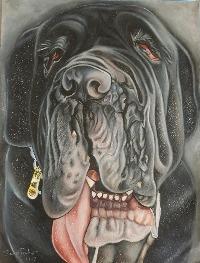scales vs axis.N.motor-pos-fb vs axis.N.joint-pos-fb
- Nitram
-
 Topic Author
Topic Author
- Offline
- Elite Member
-

Less
More
- Posts: 210
- Thank you received: 15
16 Dec 2018 17:54 - 17 Dec 2018 01:12 #122485
by Nitram
scales vs axis.N.motor-pos-fb vs axis.N.joint-pos-fb was created by Nitram
Hi.
From what I can see, the usual HAL file configuration for feedback from servo encoders is along the lines of:
net x-pos-fb <= hm2_7i76e.0.encoder.00.position
net x-pos-fb => axis.0.motor-pos-fb
Which of these two pins (axis.0.motor-pos-fb or axis.0.joint-pos-fb) provides the data to LCNC as definitive actual joint position? Am I incorrect in saying that the value of axis.0.motor-pos-fb drives the GUI screen position display, or is it ultimately driven by axis.N.joint-pos-fb?
When the motor encoder fb pin is connected to axis.0.motor-pos-fb, from what I can see, when the axis applies a backlash offset, it moves the motor/encoder the required amount but freezes the display given that the backlash move does not create any axis positional change, hence even though the encoder turns to take out the BL, the position and readout understandably stay static as this is a compensation move not one which changes joint position.
From the above, what I would be keen to know is when scales are also attached to an axis which has dual feedback via its motor encoder, if we assume that scale readings are an absolute axis position which should never really need any form of backlash, does it make more sense to connect their output to the axis.N.joint-pos-fb pin and leave the motor encoder to axis.0.motor-pos-fb?
Will doing this have any unforeseen negatives or is this even possible?
Thanks,
Marty.
From what I can see, the usual HAL file configuration for feedback from servo encoders is along the lines of:
net x-pos-fb <= hm2_7i76e.0.encoder.00.position
net x-pos-fb => axis.0.motor-pos-fb
Which of these two pins (axis.0.motor-pos-fb or axis.0.joint-pos-fb) provides the data to LCNC as definitive actual joint position? Am I incorrect in saying that the value of axis.0.motor-pos-fb drives the GUI screen position display, or is it ultimately driven by axis.N.joint-pos-fb?
When the motor encoder fb pin is connected to axis.0.motor-pos-fb, from what I can see, when the axis applies a backlash offset, it moves the motor/encoder the required amount but freezes the display given that the backlash move does not create any axis positional change, hence even though the encoder turns to take out the BL, the position and readout understandably stay static as this is a compensation move not one which changes joint position.
From the above, what I would be keen to know is when scales are also attached to an axis which has dual feedback via its motor encoder, if we assume that scale readings are an absolute axis position which should never really need any form of backlash, does it make more sense to connect their output to the axis.N.joint-pos-fb pin and leave the motor encoder to axis.0.motor-pos-fb?
Will doing this have any unforeseen negatives or is this even possible?
Thanks,
Marty.
Last edit: 17 Dec 2018 01:12 by Nitram.
Please Log in or Create an account to join the conversation.
- cmorley
- Away
- Moderator
-

Less
More
- Posts: 7248
- Thank you received: 2110
17 Dec 2018 02:15 #122501
by cmorley
Replied by cmorley on topic scales vs axis.N.motor-pos-fb vs axis.N.joint-pos-fb
axis.0.motor-pos-fb in an input pin, fed from the feedback device.
axis.0.joint-pos-fb is an output pin.
For a trivial trajectory machine they should be the same.
Chris M
axis.0.joint-pos-fb is an output pin.
For a trivial trajectory machine they should be the same.
Chris M
The following user(s) said Thank You: Nitram
Please Log in or Create an account to join the conversation.
Time to create page: 0.047 seconds
